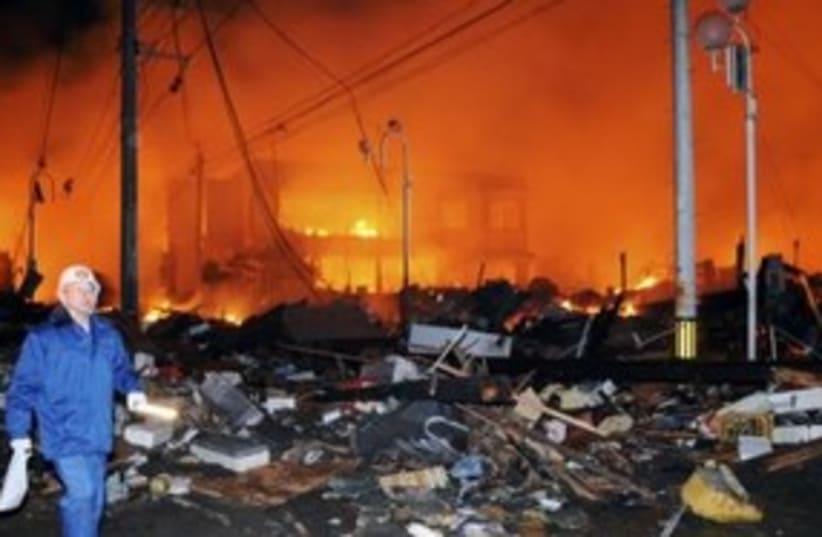RELATED:More than 1700 likely dead in Japan quake, tsunamiIsraeli search and rescue team leaves for Japan todayThousands were evacuated on Saturday following an explosion and leak from the facility's No. 1 reactor in Fukushima, 240 km (150 miles) north of Tokyo, where there is believed to have been a partial meltdown of the fuel rods.Now engineers were pumping in seawater, trying to prevent the same thing from happening at the No. 3 reactor, the government said in apparent acknowledgement that it had moved too slowly on Saturday."Unlike the No.1 reactor, we ventilated and injected water at an early stage," Chief Cabinet Secretary Yukio Edano told a news briefing.Asked if fuel rods were partially melting in the No. 1 reactor, Edano said: "There is that possiblity. We cannot confirm this because it is in the reactor. But we are dealing with it under that assumption. We are also dealing with the No.3 reactor based on the assumption that it is a possiblity."Nuclear plant operator Tokyo Electric Power (TEPCO) said radiation levels around the Fukushima Daiichi plant had risen above the safety limit but that it did not mean an "immediate threat" to human health.It said earlier it was preparing to vent steam to relieve pressure in the No.3 reactor at the plant and the government had warned of a rise in radiation during the procedure.One anti-nuclear energy NGO in Japan said the disaster should have been foreseen."A nuclear disaster which the promoters of nuclear power in Japan said wouldn't happen is in progress," the Citizens' Nuclear Information Centre said. "It is occurring as a result of an earthquake that they said would not happen."Thousands spent another freezing night huddled in blankets over heaters in emergency shelters along the northeastern coast, a scene of devastation after the 8.9 magnitude quake sent a 10-metre (33-foot) wave surging through towns and cities in the Miyagi region, including its main coastal city of Sendai.
Quake-hit Japan plant faces new radiation threat
Cooling system fails in 2nd reactor; Japan gov't admits it moved too slowly to stop reactor meltdown; tsunami deaths expected to rise above 2,000.

RELATED:More than 1700 likely dead in Japan quake, tsunamiIsraeli search and rescue team leaves for Japan todayThousands were evacuated on Saturday following an explosion and leak from the facility's No. 1 reactor in Fukushima, 240 km (150 miles) north of Tokyo, where there is believed to have been a partial meltdown of the fuel rods.Now engineers were pumping in seawater, trying to prevent the same thing from happening at the No. 3 reactor, the government said in apparent acknowledgement that it had moved too slowly on Saturday."Unlike the No.1 reactor, we ventilated and injected water at an early stage," Chief Cabinet Secretary Yukio Edano told a news briefing.Asked if fuel rods were partially melting in the No. 1 reactor, Edano said: "There is that possiblity. We cannot confirm this because it is in the reactor. But we are dealing with it under that assumption. We are also dealing with the No.3 reactor based on the assumption that it is a possiblity."Nuclear plant operator Tokyo Electric Power (TEPCO) said radiation levels around the Fukushima Daiichi plant had risen above the safety limit but that it did not mean an "immediate threat" to human health.It said earlier it was preparing to vent steam to relieve pressure in the No.3 reactor at the plant and the government had warned of a rise in radiation during the procedure.One anti-nuclear energy NGO in Japan said the disaster should have been foreseen."A nuclear disaster which the promoters of nuclear power in Japan said wouldn't happen is in progress," the Citizens' Nuclear Information Centre said. "It is occurring as a result of an earthquake that they said would not happen."Thousands spent another freezing night huddled in blankets over heaters in emergency shelters along the northeastern coast, a scene of devastation after the 8.9 magnitude quake sent a 10-metre (33-foot) wave surging through towns and cities in the Miyagi region, including its main coastal city of Sendai.